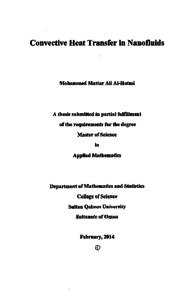Document
Convective heat transfer in nanofluids
Publisher
جامعة السلطان قابوس
Gregorian
2014
Language
English
Subject
English abstract
Nanotechnology plays an important role for the development of the modern technology. In nanotechnology heating or cooling of the nano-devices are very important for their proper functionality. Nanofluids have novel properties that make them potentially useful in many applications of heat transfer. They exhibit enhanced thermal conductivity and the convective heat transfer coefficient compared to the base fluid. Thus, nanofluids are treated as engineered colloids 21st century modern fluids.
In this thesis I use numerical technique to investigate the heat transfer characteristics of a two-dimensional steady hydromagnetic convective flow of nanofluids composed of three types of nanoparticles (copper, aluminium oxide and titanium oxide) and three kinds of base fluids (water, ethylene glycol and engine oil). The nanofluids flow over a nonlinear inclined stretching surface in which the effect of convective surface condition in taken into consideration. Using similarity transformations, the governing nonlinear partial differential equations of the physical model are transformed into nondimensional ordinary differential equations and solved for local similar solutions using very robust computer algebra software, Maple 13. The numerical simulation is carried out to investigate the role of the pertinent parameters in the flow of the nanofluids, temperature fields, rate of heat transfer and rate of shear stress.
It is found that the nanofluids velocity and temperature distributions are significantly influenced by the physical parameters entering into the analysis. The results show that the type of nanofluid is a key factor for heat transfer enhancement. I also found that addition of nanoparticles to the base fluid may not always increase the rate of heat transfer. It significantly depends on the type of base fluid and surface convection parameter. This finding is new and has not been reported in any open literature.
Member of
Resource URL
Arabic abstract
في هذا البحث قمنا رياضية بدراسة الحمل الحراري للتدفقات المغناطيسية الحرارية في سوائل تحتوي على جزيئات متناهية الصغر و تنساب فوق سطوح قابلة للاستطالة. افترضنا أن الحمل الحراري مستقل و في بعدين مع الأخذ في الاعتبار النفاذية الحرارية للسطح و زاوية ميله عن المستوى الأفقي و نوع السائل (ماء، زيت المحرك، إثيلين جلايكول) ونوع الجزيئات المتناهية الصغر (نحاس، الومنيوم ، تيتانيوم). ركزت هذه الدراسة على تقصي مدى تأثير بعض المتغيرات في النقل الحراري مثل: نوع السائل ومدی الانتشار الحراري فيه ، نوع و شكل الجزيئات المتناهية الصغر وقابليتها للتوصيل الحراري وكميتها في السائل، المجال المغناطيسي والنفاذية المغناطيسية للسطح ، زاوية ميل السطح عن المستوى الأفقي، قوة الطفو الحرارية، معامل الاستطالة للسطح، النفاذية الحرارية للسطح ، كما انها ركزت على معرفة مدى تاثير هذه العوامل على معامل الاجهاد الجانبي في المسائل تمت صياغة المشكلة الفيزيائية رياضية بمعادلات تفاضلية جزئية غير خطية من الدرجة الثانية في متغيرين س ، ص وذلك بناءا على قوانين الحركة لنيوتن" الزخم الخطي" و معادلات نفير استکس و قوانین حفظ الطاقة قمنا بحل هذه المعادلات باستخدام طريقة التحليل العددي وذلك بتحويلها إلى معادلات تفاضلية عادية غير خطية باستخدام بعض التحويلات و التحليلات الرياضية ومن ثم تم تصميم برنامج محوسب باستخدام برنامج Maple13 لإيجاد الحل النهائي لهذه المعادلات (مدى تأثير المتغيرات السابقة في الحمل الحراري).
Category
Theses and Dissertations

